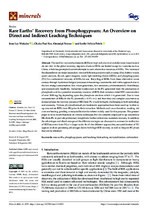| dc.contributor.author | Mukaba, J.-L. | |
| dc.contributor.author | Eze, C.P. | |
| dc.contributor.author | Pereao, O. | |
| dc.contributor.author | Petrik, Leslie | |
| dc.date.accessioned | 2021-10-11T07:37:28Z | |
| dc.date.available | 2021-10-11T07:37:28Z | |
| dc.date.issued | 2021 | |
| dc.identifier.citation | Mukaba, J-L., Eze, C., Pereao, O. and Petrik, L. (2021). Rare earths’ recovery from phosphogypsum: An overview on direct and indirect leaching techniques. Minerals. 11. 1051. 10.3390/min11101051. | en_US |
| dc.identifier.issn | 2075163X | |
| dc.identifier.uri | 10.3390/min11101051 | |
| dc.identifier.uri | http://hdl.handle.net/10566/6882 | |
| dc.description | Funding text 1
Acknowledgments: The authors acknowledge the funding from the Water Research Commission (WRC) of South Africa and express their appreciation for the academic support of the Environmental and Nano Sciences (ENS) research group at the University of the Western Cape (South Africa).
Funding text 2
The authors would like to thank the Water Research Commission (WRC) of South Africa for funding the research project through WRC K5/2483. The authors acknowledge the funding from the Water Research Commission (WRC) of South Africa and express their appreciation for the academic support of the Environmental and Nano Sciences (ENS) research group at the University of the Western Cape (South Africa). | en_US |
| dc.description.abstract | The need for rare earth elements (REEs) in high-tech electrical and electronic-based materials is vital. In the global economy, deposits of natural REEs are limited except for countries such as China, which has prompted current attempts to seek alternative resources of REEs. This increased the dependence on major secondary rare earth-bearing sources such as scrap alloy, battery waste, spent catalysts, fly ash, spent magnets, waste light-emitting diodes (LEDs), and phosphogypsum (PG) for a substantial recovery of REEs for use. Recycling REEs from these alternative waste sources through hydrometallurgical processes is becoming a sustainable and viable approach due to the low energy consumption, low waste generation, few emissions, environmental friendliness, and economic feasibility. Industrial wastes such as the PG generated from the production of phosphoric acid are a potential secondary resource of REEs that contains a total REE concentration of over 2000 mg/kg depending upon the phosphate ore from which it is generated. Due to the trace concentration of REEs in the PG (normally < 0.1% wt.) and their tiny and complex occurrence as mineral phases the recovery process of REE from PG would be highly challenging in both technology and economy. Various physicochemical pre-treatments approaches have been used up to date to up-concentrate REEs from PG prior to their extraction. Methods such as carbonation, roasting, microwave heating, grinding, or recrystallization have been widely used for this purpose. This present paper reviews recent literature on various techniques that are currently employed to up-concentrate REs from PG to provide preliminary insight into further critical raw materials recovery. In addition, the advantages and disadvantages of the different strategies are discussed as avenues for the realization of REE recovery from PG at a larger scale. In all the different approaches, recrystallization of PG appears to show promising advantages due to both high REE recovery as well as the pure PG phase that can be obtained. © 2021 by the authors. Licensee MDPI, Basel, Switzerland. | en_US |
| dc.description.sponsorship | University of the Western Cape - Environmental and Nano Sciences (ENS Department)
Water Research Commission (WRC): WRC K5/2483 | en_US |
| dc.language.iso | en | en_US |
| dc.publisher | MDPI | en_US |
| dc.subject | Acid leaching | en_US |
| dc.subject | Bioleaching | en_US |
| dc.subject | Carbonation | en_US |
| dc.subject | Phosphogypsum | en_US |
| dc.subject | Rare earth elements | en_US |
| dc.subject | REE | en_US |
| dc.subject | Recrystallization | en_US |
| dc.subject | High-tech | en_US |
| dc.subject | Electronics | en_US |
| dc.subject | Hydrometallurgical processes | en_US |
| dc.subject | Recycling | en_US |
| dc.title | Rare earths’ recovery from phosphogypsum: An overview on direct and indirect leaching techniques | en_US |
| dc.type | Article | en_US |

